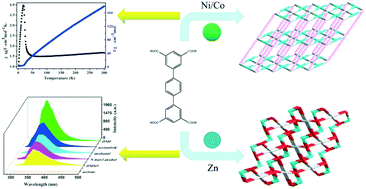Magnetic properties and luminescence sensing of five coordination polymers based on a rigid terphenyl-tetracarboxylic acid†
Abstract
Herein, five coordination polymers, namely {[Ni2(tptc)(4,4′-bibp)2]·2H2O·2cyclohexanol}n (1), {[Co2(tptc)(4,4′-bibp)2]·2H2O·2cyclohexanol}n (2), {[Zn2(tptc)(1,2-bimb)2]}n (3), {[Co(tptc)0.5(1,4-bib)]·H2O·DMF}n (4), and {[Co2(tptc)(1,2-bimb)(H2O)]·H2O}n (5) (H4tptc = terphenyl-3,3′′,5,5′′-tetracarboxylic, 4,4′-bibp = 4,4′-bis(imidazolyl)biphenyl, 1,4-bib = 1,4-bis(imidazol-1-yl)benzene, and 1,2-bimb = 1,2-bis(imidazol-1-ylmethyl)benzene) were successfully constructed based on a rigid terphenyl-tetracarboxylic acid ligand and N-containing auxiliary ligands under solvothermal conditions. Their structures were determined by single-crystal X-ray diffraction and further characterized by elemental analyses, IR spectroscopy, powder X-ray diffraction (PXRD), and thermogravimetric (TG) analyses. Complexes 1 and 2 involved a new 4,6-c 3D network structure. Complex 3 displayed an open 3D structure with the bbf topological type. Complex 4 involved an extended 3D (4,6)-c network with the point symbol of {44·610·8}{44·62}. Complex 5 had a 2D framework with the dinuclear [Co2(COO)2] SBUs. The variable-temperature magnetic susceptibilities of complexes 1, 2, 4, and 5 were also investigated, and the results indicated that the isophthalic acid bridge exhibited weak ferromagnetic coupling. Moreover, the fluorescence experiments showed that complex 3 had a potential application in the sensing of small organic molecules.



 Please wait while we load your content...
Please wait while we load your content...